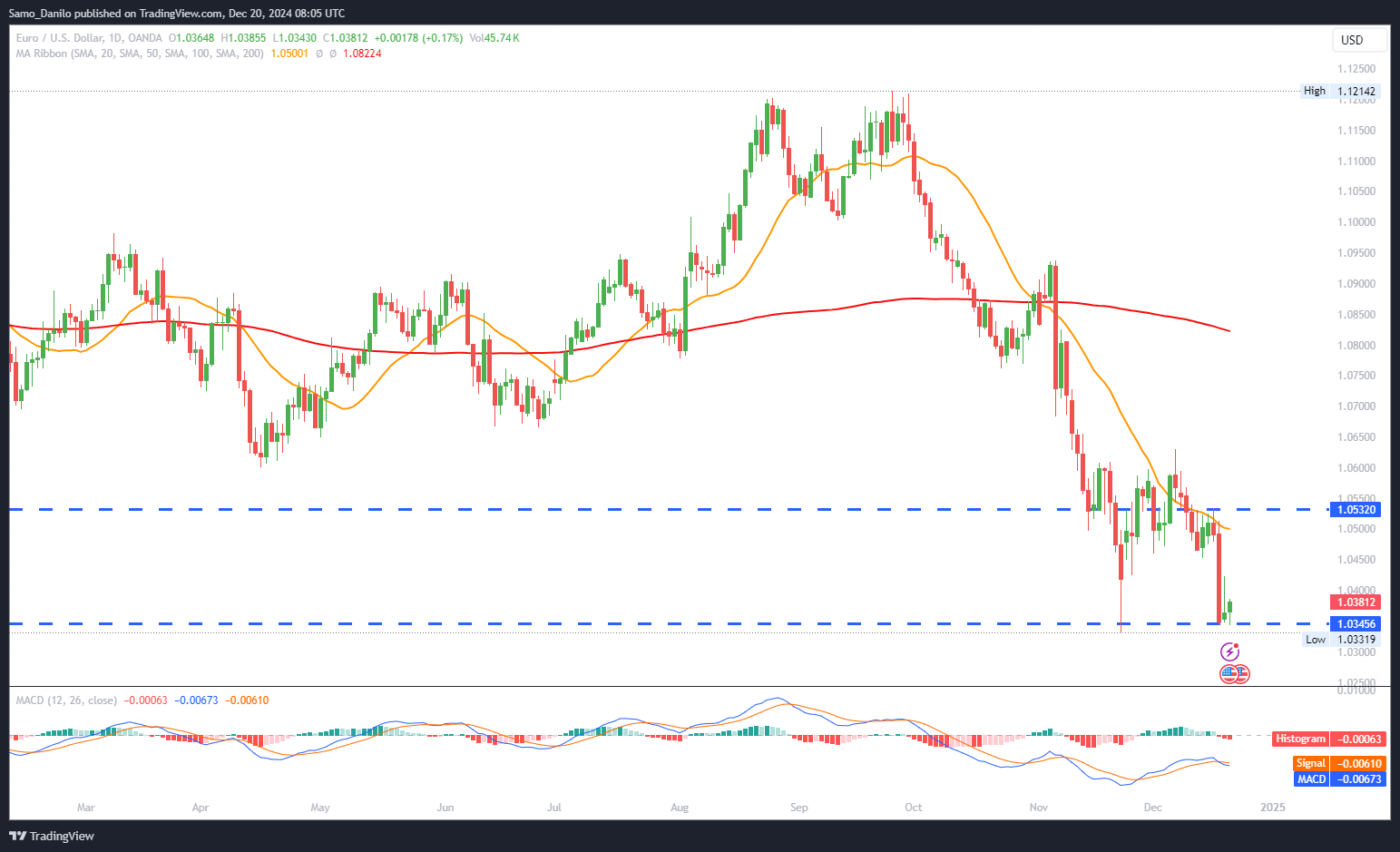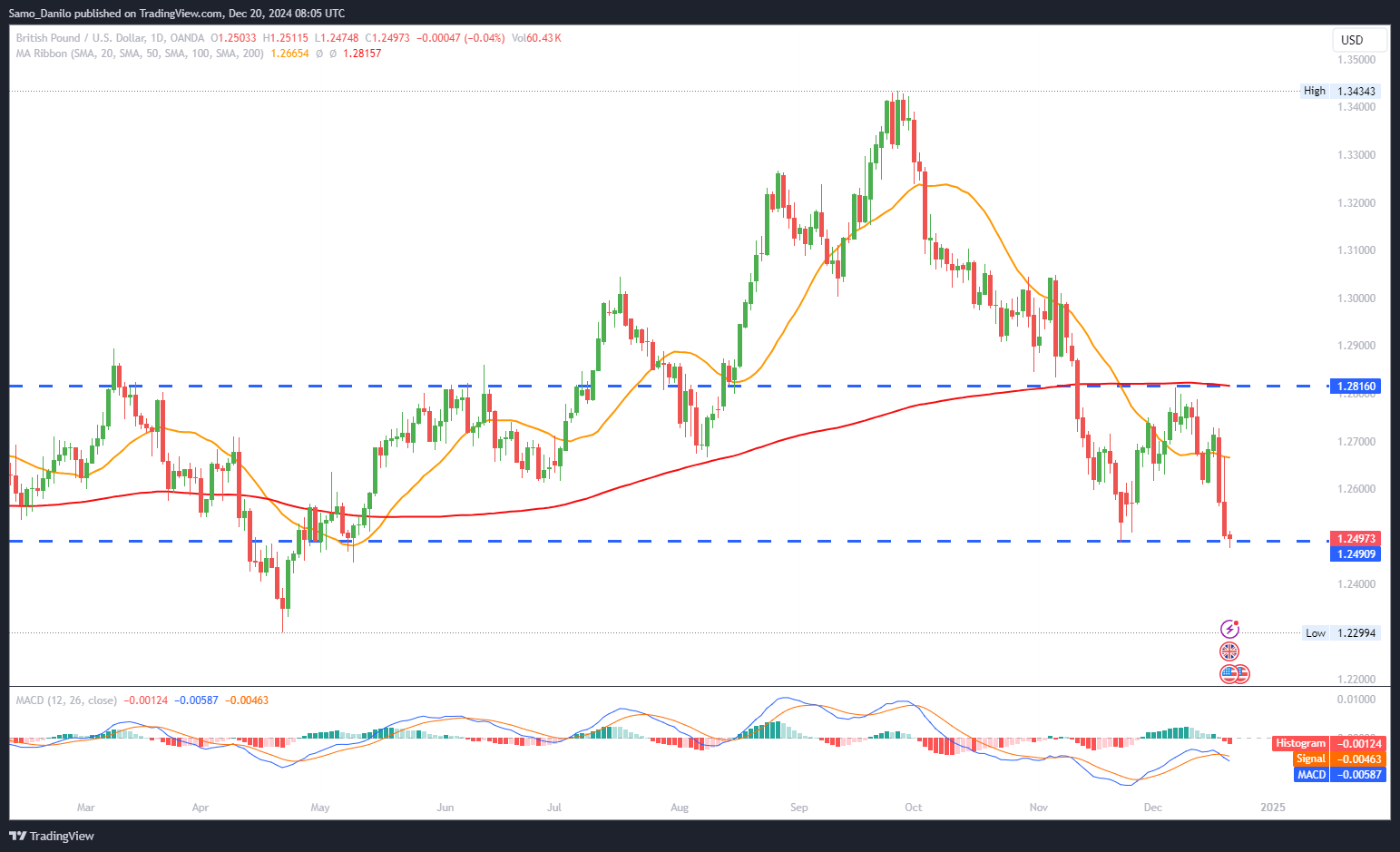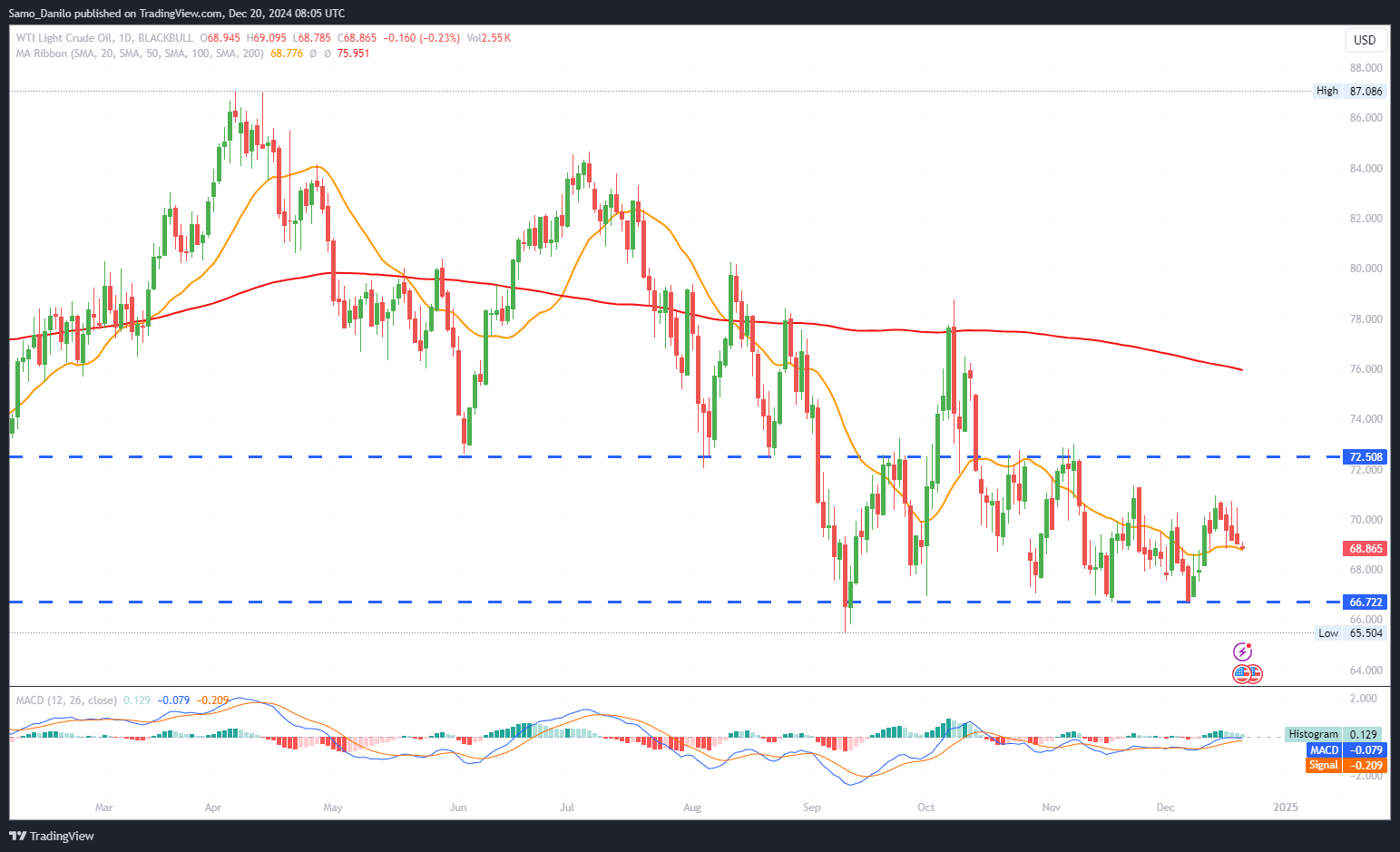EURUSD
- EUR/USD Price: The EUR/USD pair continues to trade without significant momentum, hovering around the 1.0360 mark during the European session on Friday. Persistent demand for the US Dollar (USD) amid risk aversion and post-FOMC strength limits upside potential for the pair.
- ECB Signals: The European Central Bank (ECB) implemented its fourth rate cut of the year and indicated openness to additional monetary easing in 2025. This dovish outlook has pressured the Euro, adding to concerns about the Eurozone's fragile economic outlook.
- Eurozone Current Account: The October Current Account surplus for the Eurozone came in at €26 billion, below the expected €33.5 billion. The weaker-than-anticipated figure underscores ongoing economic challenges and further dampens sentiment for the Euro.
- US Government Shutdown: Fears of a US government shutdown ahead of Friday night’s deadline continue to bolster safe-haven demand for the USD, which has reached a two-year high. The uncertainty adds to the risk-off sentiment weighing on EUR/USD.
- US PCE Inflation Data: USD bulls have temporarily paused as markets await the US Personal Consumption Expenditure (PCE) Price Index, the Federal Reserve's preferred inflation gauge, set for release later in the North American session. The outcome could influence USD strength and shape EUR/USD’s next moves.
Closing statement: The EUR/USD pair faces downward pressure amid the USD’s broad strength, driven by risk aversion and macroeconomic uncertainty. Weak Eurozone data and a dovish ECB stance further weigh on the pair. Traders will closely monitor the US PCE inflation report for additional directional cues.
GBPUSD
- GBP/USD Price: GBP/USD rebounded from its lowest level since May (near 1.2470) to the 1.2500 area. The daily chart indicates an ongoing bearish trend as the pair remains confined within a descending channel pattern, suggesting limited upside potential in the near term.
- BoE Interest Rate: The Bank of England (BoE) maintained its benchmark interest rate at 4.75% in a 6-3 vote split. Market odds for February 2025 suggest a 57% probability of holding rates steady and a 43% chance of a 25-basis-point cut, reflecting uncertainty over the BoE's next move amid mixed economic signals.
- UK Retail Sales: UK Retail Sales rose by 0.2% MoM in November, recovering from a 0.7% decline in October, according to data from the Office for National Statistics. The modest improvement supports a cautiously optimistic outlook for consumer demand as inflationary pressures ease.
- US Q3 GDP: The US Q3 Gross Domestic Product (GDP) was revised upward to an annualized growth rate of 3.1%, beating the prior estimate of 2.8%. The stronger-than-expected economic performance bolsters the US Dollar, adding pressure on GBP/USD.
- US Jobless Claims: Initial Jobless Claims for the week ending December 13 fell to 220K, down from 242K the previous week and better than the anticipated 230K. The robust labor market data further supports USD gains, limiting GBP/USD’s recovery momentum.
Closing statement: GBP/USD remains under bearish pressure, with recovery attempts capped by the USD’s strength and ongoing uncertainty surrounding the BoE's policy path. The pair’s trajectory will likely depend on upcoming macroeconomic developments and shifts in central bank expectations.
XAUUSD
- Gold Price: Gold prices hover near $2,600, supported by safe-haven demand as the US faces the threat of a government shutdown.
- Government Shutdown: The House of Representatives' failure to pass a funding bill on Thursday heightens uncertainty, bolstering the appeal of gold amid political instability.
- US GDP Growth: The US Bureau of Economic Analysis reported a stronger-than-expected 3.1% annualized GDP growth rate for Q3, revised up from 2.8%. The robust economic performance supports the US Dollar, potentially capping further gold price gains.
- Fed Projections: Federal Reserve officials forecast inflation to end 2024 at 2.8%, moderating to 2.5% in 2025 and 2.2% in 2026. Growth projections also suggest a slowdown, with GDP expected to decelerate to 2.5% in 2024 and 2.0% by 2026. These long-term outlooks signal cautious optimism, keeping gold traders wary of aggressive positioning.
- US PCE Data: Investors remain cautious ahead of the US Personal Consumption Expenditure (PCE) Price Index release on Friday. As the Fed’s preferred inflation gauge, the PCE data could influence monetary policy expectations and drive USD and gold price movements.
Closing statement: Gold prices remain range-bound near $2,600 as markets weigh political risks against robust US economic data. The upcoming PCE inflation report will likely set the near-term direction for XAU/USD, with traders balancing haven demand and USD strength.
CRUDE OIL
- WTI Price: West Texas Intermediate (WTI) crude oil prices continue to decline, trading near $68.90 per barrel on Friday, marking the fifth consecutive losing session.
- JP Morgan Predictions: Analysts at J.P. Morgan predict that oil supply will exceed demand by 1.2 million barrels per day, contributing to bearish sentiment.
- US Oil Production: Although President-elect Donald Trump has pledged to expand domestic oil drilling, the timeline for new sites and wells to become operational is lengthy. Increased production potential may align with future demand driven by Trump’s economic reforms, but short-term effects remain muted.
- China’s Energy Transition: Energy transition measures in China are significantly affecting oil consumption. Sinopec, a state-owned energy company, forecasts that the country’s gasoline demand will peak by 2027. Declining diesel and gasoline consumption further highlight challenges for crude oil in the world’s largest oil-importing nation.
- Nigerian Oil Revenues: Nigerian President Bola Tinubu aims to leverage increased oil revenues to fund ambitious government spending plans outlined in the 2025 budget. This strategy underscores the critical role of oil exports for Nigeria’s economic stability amid global market uncertainties.
Closing statement: WTI crude oil remains under pressure, reflecting oversupply concerns and demand shifts in key markets like China. However, geopolitical and economic developments, particularly in the US and Nigeria, may influence crude oil’s medium-term trajectory. Market participants will monitor these dynamics closely for price direction.
DAX
- DAX Price: The DAX fell by 1.35% on Thursday, closing at 19,970, after a marginal 0.02% loss on Wednesday. This marked its fifth consecutive session of losses, reflecting heightened investor unease following the Federal Reserve's recent policy signals and global economic concerns.
- German Consumer Sentiment: The GfK Consumer Climate Indicator for Germany rose from -23.3 in December to -22.1 in January, suggesting a slight recovery in consumer confidence. While still negative, this improvement points to cautious optimism heading into 2025.
- German Producer Prices: German producer prices surprised markets with a 0.1% year-on-year increase in November, as reported by the federal statistics office. This unexpected rise adds a nuanced layer to inflationary pressures in Europe's largest economy.
- US Labor Market: US initial jobless claims dropped from 242k to 220k for the week ending December 14, indicating continued labor market strength. This resilience, coupled with the Fed's hawkish stance, dampens sentiment for DAX-listed stocks reliant on export demand.
- US Economic Data: Focus now shifts to the US Personal Income and Outlays Report. Economists predict a year-on-year increase in the Core PCE Price Index from 2.8% in October to 2.9% in November, which could further influence demand for German equities.
Closing statement: The DAX’s persistent decline reflects global investor uncertainty amid shifting monetary policy and mixed economic data. While improving German consumer sentiment offers a glimmer of hope, US economic developments and inflation trends will play a pivotal role in shaping near-term market dynamics.




